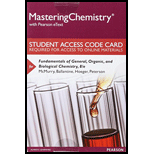
Interpretation: The role of octet rule and the position of element in the periodic table in determining the charge on an ion to be explained.
Concept Introduction:
Electron configuration: The distribution of electrons of an atom or molecule in atomic or molecular orbitals.
Octet Rule: The tendency of atoms prefers highly to have eight electrons in their outermost valence shell. In case of atom having fewer electron count less than eight, tend to react and form stable compound by gaining electrons. In case of atom having more than eight electrons tend to react and form stable compound by donating electrons.
Formation of ions:
Atom possesses equal number of protons and electrons and remains electrically neutral. By gaining (accepting electrons) or losing (donating electrons) one or more electrons, converts the neutral atom into a charged particle called IONS.
Cation: The loss of one or more electrons by a neutral atom leaves the atom positively charged called cation.
Anion: The gain of one or more electrons by a neutral atom leaves the neutral atom negatively charged called anion.
The symbolic representation of ions:
The electrons are reside in the principal quantum number ‘n’; by losing and gaining electron, reduces and increases in the electron count in the electronic configuration of the atom; for a cation adding positive charge as a superscript to the symbol of the element and for the anion adding negative charge as superscript to the symbol of the element.
Want to see the full answer?
Check out a sample textbook solution
Chapter 3 Solutions
Mastering Chemistry with Pearson eText -- Standalone Access Card -- for Fundamentals of General, Organic, and Biological Chemistry (8th Edition)
- How many electrons are in the outer shell of each of the following atoms?arrow_forwardWhat is the empirical formula of a compound that contains 72.0% carbon, 12.0% hydrogen and 16.0% oxygen by mass?arrow_forwardHow does the bonding involved in a compound (nanoscopic interactions) influence the macroscopic physical properties that can be observed of the compound?arrow_forward
- Consider the following acids and their ionization constant, determine which conjugate base is HCOOH Ka = 1.7 x 10-4 (b) HCN Ka = 4.9 x 10-10arrow_forwardHow does the bond energy of a double bond compare to that of two single bonds between the same elements? How does this relationship explain the types of reactions that compounds with double bonds undergo?arrow_forwardWhat is the pH of a 0.0032 M solution of NaOH?arrow_forward
 Principles Of Radiographic Imaging: An Art And A ...Health & NutritionISBN:9781337711067Author:Richard R. Carlton, Arlene M. Adler, Vesna BalacPublisher:Cengage Learning
Principles Of Radiographic Imaging: An Art And A ...Health & NutritionISBN:9781337711067Author:Richard R. Carlton, Arlene M. Adler, Vesna BalacPublisher:Cengage Learning

